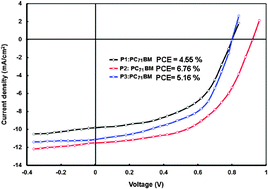Synthesis and characterization of π-conjugated copolymers with thieno-imidazole units in the main chain: application for bulk heterojunction polymer solar cells†
Abstract
In this paper the three new narrow bandgap D–A conjugated copolymers P1, P2 and P3 based on different weak donor fused thiophene-imidazole containing derivatives and the same benzothiadiazole acceptor unit were synthesized by Stille cross-coupling polymerization and characterized by 1H NMR, elemental analysis, GPC, TGA, DSC. These copolymers exhibit intensive absorbance in the range 350–900 nm and the optical bandgap lies in the range of 1.50–1.61 eV, which corresponds to the maximum photon flux of the solar spectrum. The electrochemical bandgap derived from cyclic voltammetry varies within the limits 1.47–1.65 eV and is approximately very close to the optical bandgap. The highest occupied molecular orbital (HOMO) energy level of all copolymers is deep lying (−5.24 eV and −5.37 eV and −5.25 eV for P1, P2 and P2, respectively) which shows that copolymers have good stability in the air and assured a higher open circuit voltage (Voc) for polymer BHJ solar cells. These copolymers were used as donors along with PC71BM and the BHJ polymer solar cells based on P1:PC71BM, P2:PC71BM and P3:PC71BM processed from chloroform (CF) solvent with 3 v% DIO as an additive showed an overall PCE of 4.55%, 6.76% and 5.16%, respectively.


 Please wait while we load your content...
Please wait while we load your content...